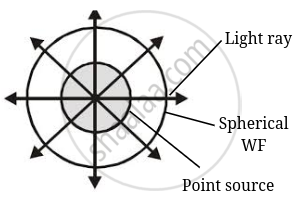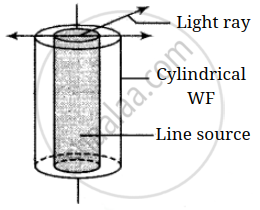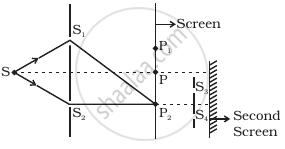Advertisements
Advertisements
प्रश्न
For light diverging from a point source ______.
- the wavefront is spherical.
- the intensity decreases in proportion to the distance squared.
- the wavefront is parabolic.
- the intensity at the wavefront does not depend on the distance.
पर्याय
a and b
a and c
b and c
c and d
उत्तर
a and b
Explanation:
| Type of wavefront | Intensity | Amplitude |
Spherical |
`I oo 1/r^2` | `A oo 1/r` |
Cylindrical |
`I oo 1/r` | `A oo 1/sqrt(r)` |
Plane |
`I oo 1/r^0` | `A oo r^0` |
Due to the point source light propagates in all directions symmetrically and hence, wavefront will be spherical as shown in the diagram.
As intensity of the source will be `I oo 1/r^2`
Where r is radius of the wavefront at any time.
Hence the intensity decreases in proportion to the distance squared.
APPEARS IN
संबंधित प्रश्न
Explain the construction of plane wavefront using Huygens’ principle.
What is the shape of the wavefront in the following case?
Light emerging out of a convex lens when a point source is placed at its focus.
State Huygen's principle.
The refractive indices of water and diamond are `4/3` and 2.42 respectively. Find the speed of light in water and diamond. (c = 3x108 m/s)
Answer the following question.
Define the term wavefront. Using Huygen's wave theory, verify the law of reflection.
Wavefront means
Figure shows a standard two slit arrangement with slits S1, S2, P1, P2 are the two minima points on either side of P (Figure). At P2 on the screen, there is a hole and behind P2 is a second 2-slit arrangement with slits S3, S4 and a second screen behind them.

How is a wavefront different from a ray?
Using Huygen's wave theory of light, show that the angle of incidence is equal to the angle of reflection. Draw a neat and labelled diagram.
Represent diagrammatically how the incident planar wavefronts of wavelength λ pass through an aperture of size d, when d is approximately equal to λ.
